Toxin, trauma, therapy?

With the help of a protein adaptor, a bacterial toxin can be applied to influence processes associated with post-trauma injury. © MPI-P
Massive tissue and organ injuries, bone fractures – so-called traumata – such as those that can occur in car accidents, activate the natural repair system in the human body in order to prevent further damage and promote healing.
For this purpose, white blood cells – so-called leukocytes – are recruited to the site of the injury, e.g. the lungs. However, this increased recruitment can also disrupt the barrier between the blood vessels and the alveoli. As a result, fluid can accumulate in the lungs and inflammation mediators are excessively produced and released into the blood.
Scientists have now achieved initial successes in modulating processes associated with the mobility of white blood cells in vitro. They hope to be able to reduce the aftermath of a blunt chest trauma, for example. Their method is based on the internal driving motor of the white blood cells, the so-called cytoskeleton, which enables the cells to move in the body.
This motor consists of molecules that combine to long chains – so-called polymers – and then convert back to single molecules again. “You can imagine the white blood cells as a submarine in the bloodstream,” says Dr. Seah-Ling Kuan, group leader at the MPI-P in the department of Tanja Weil. “The conversion process back and forth is like a small, molecular motor that advances the submarine. But, of course, it has to be driven by a fuel.”
The researchers have now found a pharmacological way to specifically turn off the “fuel” required by the white blood cells and thus might control processes associated with their mobility. They have used a platform consisting of the protein “avidin” for this purpose.
Avidin can be imagined as a small Lego brick with four studs to which other building blocks can be attached. “We have now attached a so-called peptide with special properties to three of the binding sites of avidin: The peptide is constructed in such a way that it can dock directly to a specific part of the white blood cells, i.e. it can act like an anchor,” says Seah-Ling Kuan.
The scientists assigned the fourth binding site to a special bacterial toxin. “The toxin specifically intervenes with a complex molecular signal process chain and literally turns off the fuel source,” says Prof. Holger Barth from the Institute of Pharmacology and Toxicology at the Ulm University, who is testing the effect of the construct on white blood cells with his group.
With their new avidin-based platform, the scientists have created a possibility to specifically address leukocytes and, with the help of a specific toxin-derived enzyme, to modulate processes which are associated with the supply of energy for the molecular processes that let them move in the body.
The scientists are carrying out their research within the framework of the Collaborative Research Centre 1149, in which groups from the Ulm University and the Max Planck Institute for Polymer Research work together. The aim is to investigate and understand the exact biological processes of trauma in more detail and to develop effective therapeutic approaches for accompanying symptoms. The researchers have now published their work in the renowned journal “Advanced Healthcare Materials”.
Prof. Dr. Tanja Weil
Tel.: 06131 379-131
Mail: weil@mpip-mainz.mpg.de
Dr. Seah-Ling Kuan
Tel.: 06131 379-471
Mail: kuan@mpip-mainz.mpg.de
Prof. Dr. Holger Barth
Tel.: 0731 500-65503
Mail: holger.barth@uni-ulm.de
Heck, A.; Ostertag, T.; Schnell, L.; Fischer, S.; Agrawalla, B. K.; Winterwerber, P.; Wirsching, E.; Fauler, M.; Frick, M.; Kuan, S. L. et al.: Supramolecular Toxin Complexes for Targeted Pharmacological Modulation of Polymorphonuclear Leukocyte Functions. Advanced Healthcare Materials (2019)
https://onlinelibrary.wiley.com/doi/full/10.1002/adhm.201900665
https://www.uni-ulm.de/einrichtungen/sfb-1149/ – CRC1149 at the Center for Trauma Research at the Ulm University
Media Contact
More Information:
http://www.mpip-mainz.mpg.deAll latest news from the category: Life Sciences and Chemistry
Articles and reports from the Life Sciences and chemistry area deal with applied and basic research into modern biology, chemistry and human medicine.
Valuable information can be found on a range of life sciences fields including bacteriology, biochemistry, bionics, bioinformatics, biophysics, biotechnology, genetics, geobotany, human biology, marine biology, microbiology, molecular biology, cellular biology, zoology, bioinorganic chemistry, microchemistry and environmental chemistry.
Newest articles

An Endless Loop: How Some Bacteria Evolve Along With the Seasons
The longest natural metagenome time series ever collected, with microbes, reveals a startling evolutionary pattern on repeat. A Microbial “Groundhog Year” in Lake Mendota Like Bill Murray in the movie…

Witness Groundbreaking Research on Achilles Tendon Recovery
Achilles tendon injuries are common but challenging to monitor during recovery due to the limitations of current imaging techniques. Researchers, led by Associate Professor Zeng Nan from the International Graduate…

Why Prevention Is Better Than Cure—A Novel Approach to Infectious Disease Outbreaks
Researchers have come up with a new way to identify more infectious variants of viruses or bacteria that start spreading in humans – including those causing flu, COVID, whooping cough…



